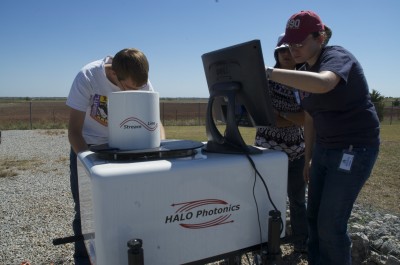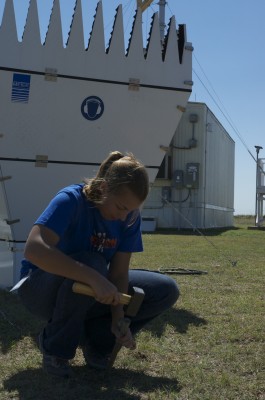When the National Weather Service released their predictions for the summer of 2013, it was difficult to miss the zone of warm colors centered over the U.S. Great Plains. Higher than average temperatures are expected in this part of the country. This comes as no surprise, especially after Oklahoma registered record-breaking heat last summer.
Scientists have known for some time now that ground temperatures strongly influence weather, particularly within the first two kilometers of the atmosphere closest to the Earth (also called the boundary layer). But how specific ground conditions—cropland versus grassland, dry or moist, color of the soil, vegetated or barren, presence of hills and trees—impact the stability of the boundary layer of the atmosphere is a relatively uncharted territory in climate science.

“The effect may not be small or insignificant,” cautioned Dave Turner, an atmospheric scientist at the National Severe Storms Laboratory (NSSL), part of the NOAA’s National Weather Center, located at the University of Oklahoma (OU).
“It [the boundary layer] is where we live and breathe. It is where mixing and weather happens,” he added.
Instability in the boundary layer leads to weather events, such as thunderstorms and tornadoes.
To investigate how land conditions impact the stability of this part of the atmosphere, Turner and colleagues at OU and Pacific Northwest National Laboratory have been conducting the Lower Atmospheric Boundary Layer Experiment, or LABLE, at the ARM Climate Research Facility’s signature site in Oklahoma over the past year.
Previously…

During this time, Turner’s team added their own instruments to the robust suite at ARM’s Southern Great Plains site (Turner’s students actually set up the instruments during the initial phase of LABLE in fall 2012). The team has gathered observations that in part, support previous findings—which is that turbulence in the boundary layer depends on wind speed, direction, and shear— but also reveal new information.
They found that the rougher the surface, the greater the turbulence. Whether these small turbulences cascade into anything big depends on how the boundary layer heats up during the daytime.
For example, a barren field, dark in color, absorbs sunlight and then gives off that heat later, after sunset. “It literally feels like hot plumes of air coming from the surface,” Turner explained. On the other hand, a moist surface, such as a grassland, absorbs the heat but does not send off such heat plumes.
“The water [in the soil] evaporates using that heat, which [the vapor] may eventually rise through the atmosphere, condense off, and then release the heat back at higher levels in the atmosphere,” added Turner. “The scenarios—or the temperature profiles of the boundary layer—will be very different in the two cases,” he said. As will the nature and the size of instabilities that these scenarios induce in the boundary layer.
During the first phase of LABLE, Turner’s team collected measurements leading up to and following some unusual weather events, including a dust storm. “The dust was so thick, the visibility was really low on Interstate 35. There were about 20 wrecks along that freeway just east of the ARM site,” he described.
The research team plans to examine several scenarios that take place on the prairies. “People tend to think of Oklahoma as flat, but there are a few hills around the SGP site, there are trees, and a variety of surface conditions,” said Turner.
Back for More
Encouraged by the success of their initial efforts, Turner requested (and received) an extension to continue the work at the SGP site. Several graduate students and a postdoctoral scientist who got a taste for hands-on field work as undergraduates in a related but different project are expected to work on this latest phase of LABLE.
“I am listed as the PI [principal investigator], but the students are really doing all the work,” admitted Turner. “They got to measure the weather that they literally observe from the rooftop of the National Weather Center,” added Turner.
“I think we will have many more exciting results,” said Turner, who has already submitted a paper with results from the first phase of LABLE for peer review.

